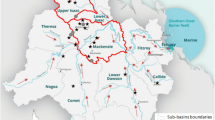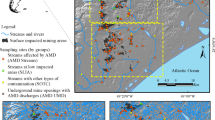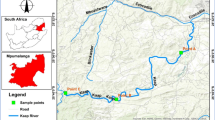Abstract
The Ranger Uranium Mine, in northern Australia, is monitored by the Supervising Scientist Division (SSD) of the Australian Government to ensure that it does not impact on the highly valued aquatic ecosystems of Kakadu National Park. In 2010, the SSD adopted the continuous monitoring of electrical conductivity (EC) and turbidity, in combination with event-triggered automated grab samples, as its primary water quality monitoring method. The continuous monitoring of EC has shown that mine discharges typically occur over short-term ‘pulse’ durations of minutes to hours. Given that magnesium (Mg) is the most likely mine-derived solute to approach or exceed the applicable water quality limit value, the focus has been on developing a pulse exposure assessment framework for Mg, as represented by its proxy EC, which is tracked by the continuous monitoring system. This study presents a possible ecotoxicologically derived Mg pulse exposure limit and trigger regulation framework for Magela and Gulungul Creeks and an assessment of historic continuous monitoring EC data from these creeks. This framework demonstrates potential to supersede the current EC guideline and associated trigger levels, which are statistically derived from historic grab sample data.







Similar content being viewed by others
References
ANZECC & ARMCANZ (2000) Australian and New Zealand guidelines for fresh and marine water quality. Australian and New Zealand Environment and Conservation Council and Agriculture and Resource Management Council of Australia and New Zealand, Canberra
Ashauer R, Boxhall A, Brown C (2005) Predicting effects on aquatic organisms from fluctuating or pulsed exposure to pesticides. Environ Toxicol Chem 25(7):1899–1912
Delos C (2008) Modelling framework applied to establishing the aquatic life criteria attainment frequency, June 2008 Draft. Office of Water, US Environmental Protection Agency, Washington DC, USA
Diamond JM, Klaine SJ, Butcher JB (2006) Implications of pulsed chemical exposures for aquatic life criteria and wastewater permit limits. Environ Sci Technol 40:5132–5138
ERA (2012) Ranger mine management plan 2012. Energy Resources of Australia, Darwin
European Commission (2003) Technical guidance document on risk assessment in support of Commission Directive 93/67/EEC on Risk Assessment for new notified substances: part II. Office for Official Publications of the European Communities, Luxembourg
Gordon AK, Mantel SK, Muller NWJ (2012) Review of toxicological effects caused by episodic stressor exposure. Environ Toxicol Chem 31:1169–1174
Hogan A, van Dam RA, Markich SJ, Camilleri C (2005) Chronic toxicity of uranium to a tropical green alga (Chlorella sp.) in natural waters and the influence of dissolved organic carbon. Aquat Toxicol 75:343–353
Hogan AC, Trenfield MA, Harford AJ and van Dam RA (2013) Toxicity of magnesium pulses to tropical freshwater species and the development of a duration-based water quality guideline. Environ Toxicol Chem. doi:10.1002/etc.2251.
Iles M (2003) Review of water quality triggers, November 2003 progress report. Internal Report 463, November, Supervising Scientist, Darwin. http://www.environment.gov.au/ssd/publications/ir/pubs/ir463.pdf.
Iles M (2004) Water quality objectives for Magela Creek—revised November 2004. Internal Report 489, December, Supervising Scientist, Darwin. http://www.environment.gov.au/ssd/publications/ir/pubs/ir489.pdf.
Klessa D (2001a) Water quality in Magela Creek upstream and downstream of Ranger: a summary of findings for the 1999–2000 wet season. Internal Report 360, Supervising Scientist, Darwin. http://www.environment.gov.au/ssd/publications/ir/pubs/ir360.pdf.
Klessa D (2001b) Water quality in Magela Creek upstream and downstream of Ranger: a summary of performance for 2000–2001 and derived triggers and limits for 2001–2002. Internal Report 380, Supervising Scientist, Darwin. http://www.environment.gov.au/ssd/publications/ir/pubs/ir380.pdf.
Milnes AR (1988) Rock weathering in the waste dumps at the Ranger Project Area, East Jabiru. Focus Report No. 3 to Ranger Uranium Mines Pty Ltd.
O’Connor R, Humphrey CL, Dostine P, Lynch C and Speirs A. (1995). A survey of aquatic macroinvertebrates in lentic waterbodies of Magela and Nourlangie Creek catchments, Alligator Rivers Region, Northern Territory. Internal Report 225. Supervising Scientist for the Alligator Rivers Region, Canberra. http://www.environment.gov.au/ssd/publications/ir/pubs/ir225.pdf.
Press T, Lea D, Webb A, Graham A (eds) (1995) Kakadu: natural and cultural heritage and management. Australian Nature Conservation Agency/North Australia Research Unit, the Australian National University, Darwin, p 318
RUEI (1977) The Ranger Uranium Environmental Inquiry second report. Australian Government Publishing Service, Canberra
Stephan CF, Mount DI, Hansen DJ, Gentile JH, Chapman GA, Brungs WA (1985) Guidelines for Deriving Numerical National Water Quality Criteria for the Protection of Aquatic Organisms and their Use. NTIS PB 85-227049, US Environmental Protection Agency, Washington DC, USA
Supervising Scientist (2000). Investigation of tailings water leak at the Ranger uranium mine. Supervising Scientist Report 153, Supervising Scientist, Darwin. http://www.environment.gov.au/ssd/publications/ssr/pubs/ssr153-full.pdf
Supervising Scientist (2011). Annual report 2010–2011. Supervising Scientist, Darwin. http://www.environment.gov.au/ssd/publications/ss10-11/pubs/annual-report-10-11.pdf
Supervising Scientist Division (2012). Surface water chemistry monitoring protocol to assess impacts from the Ranger Mine. Internal Report 609, December, Supervising Scientist, Darwin. http://www.environment.gov.au/ssd/publications/ir/pubs/ir609.pdf.
van Dam RA, Hogan AC, McCullough CD, Houston MA, Humphrey CL, Harford AJ (2010) Aquatic toxicity of magnesium sulphate, and the influence of calcium, in very low ionic concentration water. Environ Toxicol Chem 29(2):410–421
van Dam RA, Humphrey CL, Harford AJ, Sinclair A, Jones DR, Davies S and Storey AW (2013) Site specific water quality guidelines: 1. Derivation approaches based on physicochemical, ecotoxicological and ecological data. Environ Sci Pollut Res. http://dx.doi.org/10.1007/s11356-013-1780-0
Author information
Authors and Affiliations
Corresponding author
Additional information
Responsible editor: Philippe Garrigues
Rights and permissions
About this article
Cite this article
Sinclair, A., Tayler, K., van Dam, R. et al. Site-specific water quality guidelines: 2. Development of a water quality regulation framework for pulse exposures of mine water discharges at a uranium mine in northern Australia. Environ Sci Pollut Res 21, 131–140 (2014). https://doi.org/10.1007/s11356-013-1922-4
Received:
Accepted:
Published:
Issue Date:
DOI: https://doi.org/10.1007/s11356-013-1922-4




